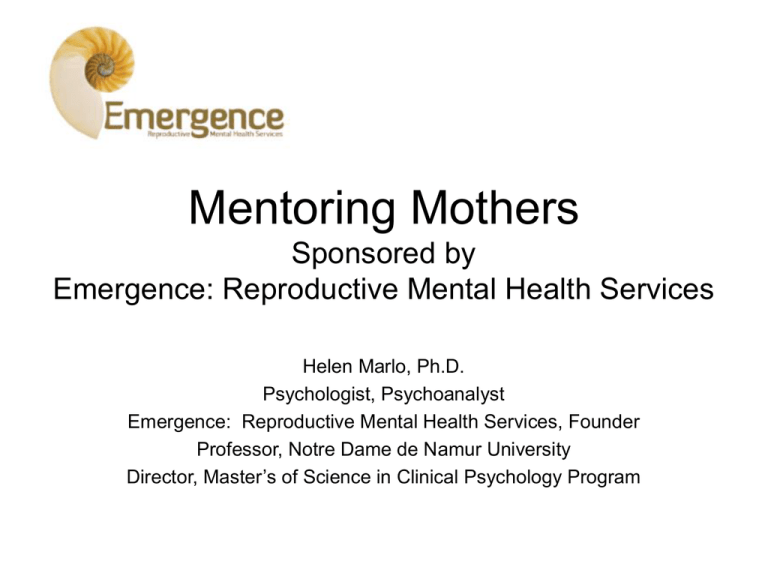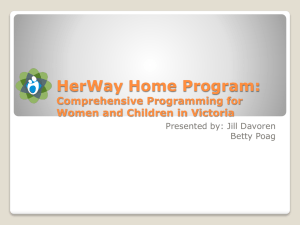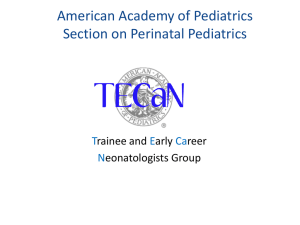transitioning to motherhood - Emergence Reproductive Mental Health
advertisement

Mentoring Mothers Sponsored by Emergence: Reproductive Mental Health Services Helen Marlo, Ph.D. Psychologist, Psychoanalyst Emergence: Reproductive Mental Health Services, Founder Professor, Notre Dame de Namur University Director, Master’s of Science in Clinical Psychology Program PSYCHOLOGY OF PERINATAL PERIOD: A time of profound personal reorganization, transition, and development, involving a normal period of increased anxiety and (unconscious) conflict in women which manifests to encourage self-evaluation to meet new developmental challenges, and to mobilize care and sensitivity to the newborn. (Klaus, Kennell, & Klaus, 1995). COMMON PERINATAL STRUGGLES: Perinatal issues are normal and universal while significant struggles occur in over 20-25% of women and frequently co-occur in partners and children. Anxiety Trauma including Post-Traumatic Stress Disorder Grief and Loss Depression Personality Patterns: Perfectionism High expectations Critical Obsessive Compulsive Rigidity Helpless/dependent Self-reliant/independent Avoidant Self-negligent Self-absorbed Bonding and Attachment Problems: • Detached or overly, inconsistently, or chaotically attached Developmental challenges and transitions Relationship/Marital/Partner Issues Unresolved Past Issues Concerns about Parenting and Parenthood Pregnancy Related Concerns Psychosomatic Problems Eating Disturbances Substance Abuse Addictions PERINATAL ANXIETY, TRAUMA, & POST-TRAUMATIC STRESS DISORDER: ANXIETY: While estimates of perinatal depression range from 10-20% of new mothers, perinatal anxiety appears to be more prevalent (Jaffe & Diamond, 2011) and frequently co-occurs with depression. to prehormone Increased pregnancy fears and anxiety, not general stress is related term births possibly from elevated corticotropin-releasing (Dunkel-Schetter & Mancuso, 2010). Up to 75% of mothers with preschoolers report significant anxiety (Maushart, 1999). POST-PARTUM POST TRAUMATIC STRESS SYMPTOMS/DISORDER (PTSS/PTSD): ➢An experience of childbirth where one believes her life or her baby’s life was threatened; and includes feeling helpless, out of control, alone, and unsupported. ➢Research has increased as this has gained more reputable clinical attention. When Survivors Give Birth (2004) by Penny Simkin and Phyllis Core symptoms revolve around re-experiencing, avoidance, and Klaus PERINATAL ANXIETY, TRAUMA, & POST-TRAUMATIC STRESS SYMPTOMS/DISORDER: Rates of postpartum post-traumatic stress disorder range from 1.5-9%. Between 25%-34% of women report traumatic births and 1.5-3% of women with clinically normal births developed PTSD (Soet, et al, 2003, Creedy, et al, 2002, Czarnocka, et al, 2000, Beck, 2005, 2006, Ayers, 2007). ➢Nationwide study of 1,373 postpartum women found 9% met diagnostic criteria for PTSD while 18% had significantly elevated symptoms (Beck, 2011). ➢A review of 31 studies on post-traumatic stress after childbirth concluded it is common and under-recognized (Olde, 2005). Risk factors included: a history of psychological problems, trait anxiety, obstetric procedures, negative contact between birth professionals and mother, feelings of loss of control, and lack of partner support. ➢PTSD/PTSS have significant, negative, long-term impact on: mood, behavior, social relationships, future pregnancy and childbirth, partner relationship, sexual functioning, mother-baby bonding and attachment, long-term attachment problems, especially avoidant or anxious attachments. POST-PARTUM POST-TRAUMATIC STRESS SYMPTOMS/DISORDER: RISK FACTORS DURING LABOR (Beck, 2011; Waldenstrom 2004; Soet, 2003;Creedy, 2000; Thom, 2007; Soderquist, Wijma 2002; Olde 2005: Ayers, 2007 Gamble, 2005; Gross, 2005; Cigoli, 200) Unexpected medical problems High level of obstetric intervention Cesarean birth Perception of inadequate labor support Instrumental delivery Infant in NICU Poor experience with pain Lack of choice and loss of control over labor Unmet expectations especially without explanation Negative interactions with hospital professionals and staff Poor partner support Feelings: powerless, alone, defeated, thoughts of death Prenatal depression and anxiety Traumatic life events and (childhood) sexual trauma history Dissociation ➢An inability to talk coherently about her birth story, coupled with negative perceptions of professionals and staff, are significant risk factors for PTSS or PTSD Factors associated with Perinatal Emotional Problems ➢ Physical factors: Previous psychiatric history and care Menstrual problems Imbalances: hormones, neurotransmitters, nutrients Fatigue and disrupted sleep Socio-cultural factors: Inadequate cultural recognition Absence of traditions/rituals including “transition and ➢ reintegration rituals” Insufficient social support and social isolation Socioeconomic problems Birth and Infant Factors: Difficult or traumatic pregnancy, labor or birth Discrepancy between expectations and subsequent experience Disappointment with birth and experiences with professionals History of obstetric problems, infertility, stillbirth, or miscarriage Significant problems with infant ➢ Psychological Factors: Poor relationship with partner/marriage Negative perceptions of parental care during one’s childhood Poor relationship with parents especially absent or poor mother daughter relationship Less paternal involvement and support of infant’s care Ignorance of infant development Distorted self-esteem and self efficacy (high or low) Unrealistic expectations of motherhood Lack of satisfaction with educational achievement Little previous contact with babies Prolonged conception period in women over 30 Oppressive past memories History of sexual or physical trauma and abuse Fear of childbirth Unresolved traumas or losses Stressful life events Maternal age (younger and older) Lack of control over returning to work Developmental Considerations: Transitioning to Motherhood "What’ll I do with it now” Developmental Considerations: Transitioning to Motherhood Developmental Considerations: Transitioning to Motherhood TRANSITIONING TO MOTHERHOOD: “The mother having been a child and having introjected the memory traces of being… cared for…relives with her infant the pleasures and pains of infancy…Parents meet.. not only the projections of their own conflicts incorporated in the child, but also the promise of their hopes and ambitions.” (Benedek, 1959) “Motherhood is earned first through an intense physical and psychic rite of passage—pregnancy and childbirth—then through learning to nurture, which does not come by instinct.” (Rich, 1995) ➢ Pregnancy and birth is often a time of maternal rebirth. A vulnerable time, it triggers a process of self-reorganization and personal evaluation. (Stern, 2002). Motherhood is characterized by paradox, contradictions and opposites that generate anxiety (deMarneffe, 2004; Maushart, 1999; Raphael-Leff, 1993). Mothers can have innate capacities for nurturing and yet sustained nurturance over time is learned. Mothers can feel instantly connected with their child and yet genuine bonding and attachment is a long-term process. Motherhood is accompanied by many gains and losses. Mothers who are less reflective and less tolerant of ambiguity suffer more perinatal problems (Siegel, 2002; Raphael-Leff, 1993) Birth into motherhood is filled with powerful myths, images and expectations, and sanctioned by cultural assumptions about motherhood and “good mothers:” ➢ Images: “Good” versus “bad” mothers; traditional versus non-traditional images of mothering; being like or unlike one’s childhood experience Personal evaluation during maternal rebirth (Stern, 2002): Imagined mother meeting real mother: Will I be like my mother? Will I be better or worse than my mother/parents? Will I replicate my childhood? Imagined baby meeting real baby: “good” or “bad;” divine child or devil; flawless or deformed Imagined birth meeting real birth: perfectly as planned; “perfectly” natural or “perfectly” medicated; completely in control or completely out of control Imagined baby’s effect on mother meeting real effect: unconditional love; replacement baby; antidepressant; conciliator for family of origin; restoring and stimulating new relationship with mother; escaping the destiny of one’s past Imagined baby’s effect on marriage meeting real effect: marital glue or marital threat; competitor Imagined family meeting real family: baby as carrier of flaws; baby as gift; social mobility; role in the family mythology The Reciprocator-Facilitator-Regulator Model: Patterns of relating to pregnancy, birth, post-partum, and mothering (Raphael-Leff, 2005): The Reciprocator: Ambivalence and contradictory reactions Tolerant of ambiguity and uncertainty Maintains parts of self while losing and developing new parts Attuned to needs of infant and self The Facilitator: Immerses completely Expects to relish Relinquishes self and previous life Adapts “devotedly” to child’s life The Regulator: Strives to control and regulate Detachment and minimization Determination to minimize, deny, control changes; and maintain “pre-pregnancy” self Regulates and controls the baby TRANSITIONING TO PARENTHOOD: Marital conflict increases dramatically, and marital quality decreases for 40-67% of couples within the first year of baby’s life. “Bringing Baby Home” program decreased postpartum depression (22.5% versus 66.5% in control group) by improving couples relationship, educating on infant development, involving fathers in infant care. (Shapiro & Gottman, 2005). TREATMENT: ➢ Preventive care: Preparation before or during pregnancy. Address family of origin issues, unresolved traumas, losses, and relationship patterns. ➢ Professionally facilitated support groups have been especially helpful with perinatal problems (Jaffe & Diamond, 2011). Integrative Treatment: Psychosocial and educational interventions, individual and group psychotherapy, medication, peer interventions, somatic work; and integrative/complementary medical and psychological treatments including relaxation therapy, yoga, massage, mindfulness, meditation, and hypnotherapy are effective with perinatal problems (Jaffe & Diamond, 2011; Siegel, 2003). Psychotherapy: Brief to long-term. Relevance of trauma therapy. May involve individual; parent and infant; couple; or family and include integrative/complementary treatments. MENTALIZING AND NARRATION: Their power in therapeutic work Mentalizing: Understanding mental states in self and others—holding mind in mind. The process of thinking about thinking. Capacity to “feel thoughts,” and “think feelings,” in self and others. Includes explicit and implicit information. Narrative: Construction of a story. Coherent narratives relate to mental health. Coherence: Story is believable, congruent, undistorted, sufficiently elaborated, collaborative, & reflective of self/others. predict vulnerable Narratives that are coherent and demonstrate mentalizing better relationships and mental health, including with populations. Research on Mentalizing [Reflectiveness] and Narrative: Pregnant mothers who were self-reflective [“mentalizing”] about their early histories and able to share a coherent story of their early life [“narrating”], when three months pregnant, had less anxious children who demonstrated secure attachment at eighteen months (Fonagy, et. al, 1993). mothers with significant adversity and deprivation, but high reflectiveness ratings, demonstrated secure attachment relationships with their children, while only one of seventeen deprived mothers, with low reflectiveness ratings had secure children (Fonagy, Steele, Moran, Steele, and Higgitt, 1991a) The relevance of the narrative of “the reproductive story”: “the, at times conscious, but largely unconscious, narrative” created “about parenthood.” (Jaffe & Diamond, 2011) CLINICAL CONSIDERATIONS: ➢ Initially align with challenging emotional states with empathy. Complementary reactions where patient is challenged, provided “the other side,” encouraged “out” of her experience, is a more natural and common response, but usually less helpful initially. Acknowledge limits to empathically knowing her experience. ➢Attunement to language: Process not content; engagement with non-verbal, verbal, and somatic dimensions of experience Affirm the benefits of an integrated approach to her health: Help target one area that is within her capacity to influence. Attunement to PTSD symptoms particularly: re-experiencing; avoidance; or arousal. Affirm benefits to child and her of receiving earlier treatment. ➢Affirm the healing power of telling her story. Less coherent narratives related to more problems and indicates greater need for treatment. A mother who develops and articulates a “coherent narrative” of her life story shows greater mental health, healthier parenting, improved relationships with her partner and children, and has children who demonstrate more security and better capacity for relating (Siegel, 2003). The un-narrated past, not the past, impacts the present. Narration fosters neural integration of the right and left hemispheres (Teicher, 2002), which leads to improved emotional regulation, and more conscious choices. Meets the human need to be heard, seen, and valued. ➢Affirm the influence of “the reproductive story,” and the value of working mindfully with it. ➢Consider referring a patient to “Mentoring Mothers,” a group that provides mentoring, education, consultation, community, and support that focuses on fostering emotional and psychological development for a more conscious transition to motherhood.






